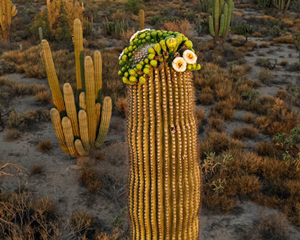On a bright spring day, a lone 28-foot cactus towered above the dusty scrub within Saguaro National Park in Arizona.
在一個春光明媚的日子,亞利桑那州的巨人柱國家公園里,一株高約28英尺的仙人掌孤伶伶地矗立在底下的灌叢中。
Despite the cloudless sky and oven-like heat, the spiky giant looked strong and healthy.
盡管萬里無云、熱如烤箱,這株長滿尖刺的巨柱看來仍舊強壯健康。
Rain had recently fallen in the park, and the plant's pleated sidewalls were extended, retaining hundreds of gallons of water inside.
公園剛下過雨,這株植物的皺褶外壁此刻鼓脹了起來,里面留住了幾百公升的水分。
Such internal reservoirs help cacti thrive where other plants would instantly wilt.
像這樣的內在儲水庫,讓仙人掌在其他植物立刻就會枯萎的狀態下,依然能夠健全生長。
But the saguaro species (Carnegiea gigantea), native to the Sonoran Desert in the United States and Mexico, hides another evolutionary trick.
但原生于橫跨美國與墨西哥的索諾蘭沙漠中的巨人柱這個物種,還藏著另一個進化上的小手段。
To capture it in action, a park biologist named Don Swann had arrived with an extra-long, custom-made telescoping pole and camera mount system that he extended toward the giant's crown.
為了捕捉這個機制的運作實況,國家公園的生物學家唐·斯旺帶著一支特別長的特制伸縮桿和相機架設系統來到這里,朝這株巨人柱的頂端伸上去。
Then he snapped several digital photos, the latest in a set of images he'd been taking for several weeks.
然后他拍了幾張數碼影像,他已經拍了好幾個星期了,這是這組影像中最新的幾張。
Later that afternoon, Swann reviewed the time-lapse series and pointed out that "something miraculous" was happening.
當天下午稍晚,斯旺檢視了這系列的縮時影像,并指出有“神奇的事情”發生了。
The photos highlighted an array of tightly shut white-and-yellow flowers that ringed the top of the plant.
照片主角是環狀排列在植物頂端、緊密閉合的許多黃白色花朵。
Saguaro flowers bloom only once and typically at night to protect their delicate internal anatomy from long hours of intense sun.
巨人柱的花只開一次,通常都是在晚上,以免嬌弱的內部結構遭受烈日長時間的炙烤。

But the photos, when viewed sequentially, revealed something else: The buds appeared to be moving.
但如果按照時間順序查看這些照片,會發現它還透露了別的事情:花苞似乎在移動。
From mid-April through mid-June, the flowers were slowly migrating in a counterclockwise fashion, traveling radially from the plant's eastern face to its northern side, which offered more consistent shade.
從4月中到6月中,花朵緩慢地以逆時針方向遷移,從植物的東面環狀移動到北面,因為那邊的遮陰比較穩定。
"This could allow saguaros to take advantage of warmer temperatures, and more sun, during the cooler early spring, while minimizing the more deleterious heat effects later in the season," Swann suggested.
“這讓巨人柱在涼爽的早春時節能利用比較溫暖的溫度和更多陽光,然后到了晚春,又能讓比較有害的熱量影響降到最低”,斯旺指出。
Over the past half decade, Swann and other park scientists have teamed up with a group of citizen scientists to photograph 55 saguaros, becoming the first researchers to confirm with visual evidence that this floral migration happens annually.
過去五年來,斯旺和公園其他科學家及一群公民科學家組織起來,拍攝了55株巨人柱仙人掌,首度以視覺證據證實花朵年年都會這樣遷移。
This is just one trait associated with just one species: All told, there are more than 1,500 known species of cacti, which, while still threatened by the unpredictability of climate change and human encroachment, continue to live in some of the harshest climates on Earth.
這還只是跟一個物種有關的一個性狀而已:世界上已知的仙人掌總共有超過1500種,它們在無法預測的氣候變化與人類進逼的威脅下,持續生長在地球上某些最嚴酷的氣候環境中。
"A lot of the stories that have come out about cacti are fearful and negative," says desert plant ecologist Ben Wilder, director of the Next Generation Sonoran Desert Researchers, an organization that connects experts across the border between Mexico and the U.S.
“關于仙人掌的故事,有很多都是恐怖又負面的。”沙漠植物生態學家班·懷爾德說,他是“新一代索諾蘭沙漠研究者”的主任,這個組織連接起了美國與墨西哥的專家。
"To me, cacti are such a beautiful story of adaptation to arid environments and all these different strategies of resilience and prosperity."
“對我來說,仙人掌是一個關于適應干旱環境的美好故事,展現了關于韌性與蓬勃生長的種種策略。”
For researchers, cacti now represent a new frontier of survival, one offering surprising lessons that, if harnessed correctly, could be applied to a world far beyond them.
對研究者來說,仙人掌現在就代表著生存的最新疆域,提供了各種驚人的新知,如果能駕馭得當,就有機會運用在仙人掌以外的廣闊世界。



